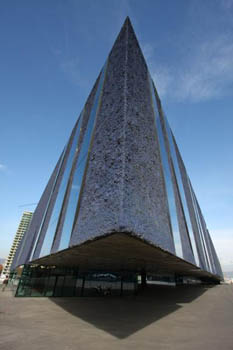Product Description
Wolfgang Gessl Cone teapot 1996


WOLFGANG GESSL (b. 1949) Austria / Sweden
Cone Teapot 1996 (designed 1995)
Hand wrought and hand hammered silver cone shaped covered pitcher form with a green PVC handle and spout over silver cylindrical arching forms
Marks: Wolfgang Gessl (script impressed signature), WO.GE (in a rectangle), Swedish assay mark for Stockholm, 925 (silver guarantee in a rectangle), X10 (in a rectangle), 2/9 GD 452
Illustrated: Gold and Silversmith Wolfgang Gessl: Exceeding Geometry, Kerstin Wickman, p. 19.
H: 8 3/8” x W: 8 ½” x Dia base: 5 ¼”
This is No. 2 out of the edition of 9 models.
Price: $22,500
Wolfgang Gessl was born in 1949 in Vienna, Austria and trained as a goldsmith with Professor Hans Angerbauer. Upon moving to Sweden, Gessl studied under the eminent silversmith Sigurd Persson at Konstfack, the National University of Art, Craft and Design in Stockholm, Sweden.
Wolfgang Gessl has had fifteen solo exhibitions including shows at The National Museum, Stockholm and The Royal College of Art in London. His metalwork has been widely exhibited in Sweden, Europe and the U.S and his pieces can be found in many private collections throughout the world. He has taught at Konstfack for more than twenty-four years, and continues to live and work in Stockholm.
Wolfgang Gessl Cone teapot 1996
JOSEF RIEDEL GLASWERKS Dolni Polubny, Bohemia
BAKALOWITS SÖHNE Vienna
Carafe c. 1900
Clear crystal engraved with a peacock feather (gilding)and inset with an applied colored-glass peacock eye
For more information see: Das Böhmische Glas 1700-1950, Band IV Jugendstil in Böhmen, Alena Adlerová, c.s. (Passau: Passauer Glasmuseum, 1995) pp. 202 – 210.
Carafe: H: 10 ½” D of base: 6 “
Price: $3,650
WERNER MANTZ (1901-1983) Germany
Untitled 1929 (vintage)
Silver gelatin print, patinated bronze frame
Signed: W. Mantz 1929 (in pencil on back)
Framed size: H: 8 ¾” x W: 11”
Price: $42,500
Werner Mantz is regarded as one of the most gifted architectural photographers of the twentieth century. His talent in this field we recognized early in his career and he received numerous commissions from a variety of prominent architects, first in Germany and later in the Netherlands. His work in Cologne especially, from the mid-1920s to the early 1930s, forms a definitive statement of the Neue Sachlichkeit movement in architecture.
Works by Werner Mantz can be found in the collections of the Metropolitan Museum of Art in New York, The Museum of Modern Art in New York, The Art Institute of Chicago, Tate London and many more.
